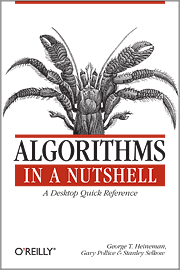|

|
The short history of computer science has sparkled with some extraordinary insights into getting jobs done efficiently. In some ways those jobs are familiar, such as moving the maximum volume of stock from factories through distribution channels to shops. Or sorting a directory of names into alphabetical order. But the solutions that have been found in recent years are genuinely new, and interesting to read about.
This book takes us through the development of several classes of algorithms, such as from "sequential search", through "binary search" to "binary tree search" and a "hash based search". Similarly, it explores sorting into order, finding connected nodes in a graph, planning winning moves in a game, allowing a maximum flow through a network, and geometric problems like the closest points in a set to a new point. The algorithms are presented in order of complexity, building up each topic and explaining both the method and performance of each. Each one covers several pages, including a pseudo-code listing, an actual listing in a language like C++ or Java (supported by the full source code in an archive somewhere), performance statistics and a discussion. The building-up means that many of the algorithms presented are of little interest to practical implementors, however.
The authors are rightly proud of each page that summarises an algorithm. The pseudo code, although variable in style, is mostly very clear and easy to follow. Each algorithm is presented with a diagram demonstrating its progress in an example highlighting the key lines of code. The actual source code can be used if you're implementing it, but since most of the algorithms are presented to teach an approach, using them directly is not necessary. A few lines of pseudo code are too abstract, such as "find median value" or "find augmenting path".
One of the most interesting things about efficient algorithms is the way that they make simplifying assumptions about the data; perhaps that no two items in a set can be unique, or perhaps that data is stored in a balanced structure. Indeed the book begins with a case study of a memory leak analysis tool which was terribly slow to run. It used a tree to store the allocated blocks, but unfortunately the sequence in which blocks were assigned from the heap meant that this tree turned out more like a linked list!
That question of using the right data structures is hinted at repeatedly, and often enforced within the algorithms, but I felt that a programmer working with such problems could benefit from some further guidance through the initial steps of considering "what kind of operations will I want to perform on my data?". Getting the right structure, or caching intermediate results is often vital to efficient performance. The authors recognised this, but didn't help much with the decisions.
Performance is always discussed in terms of run-time and has been measured on just a desktop PC, and a really big PC. There are more embedded devices with relatively tiny resources in use, and a few important data-centre mainframes, which the authors disregard.
The balance of topics in the book seems to be aimed at a student revising algorithm design. But the lectures on floating point inequality, pointers, and the importance of freeing allocated memory, seem out of place. The statistics are not built on the strongest foundations (the methods and explanations are a bit suspect, and some graphs are difficult to read). Some terms are defined in detail, such as "secondary storage" whereas others are not, such as "median".
There are a few errors in diagrams, and an extraordinary non-sequiteur over the turn of a page, from user authentication to graph-spanning paths, which had me flipping the page several times to see if I had missed something. Although locally confusing, they didn't put me off my stride.
The key question that the book sets out to answer, of how to choose the best algorithm for a problem that needs to be delivered on Friday, remains somewhat elusive. There are few real-world examples of data sets that fit the algorithms described, and I felt that more space could have been given to a wider range of algorithms instead of the academic development of a single type of algorithm.
The book ends with an excellent couple of chapters; on the kind of assumptions you can make to convert your data into a well known case, and the "principles" that all software engineering with heavy duty algorithms should consider.
In summary, the book is strongest in its disciplined presentation of pseudo-code and structured sections answering the same questions about each topic. However, the ideal target audience for it would seem to be limited to students, rather than real software engineers.
